QuickBooks error 6000 1076 is a common 6XXX series error that occurs while accessing the company file that contains all your business’s crucial information. This usually happens when the QuickBooks installation is damaged, among other possible reasons. To fix error 6000 1076 in QuickBooks, you need to perform solutions, like downloading QB updates and running the QuickBooks File Doctor tool. In this article, we will discuss the troubleshooting solutions to resolve this error in detail and the causes to avoid the same in the future.
General Solutions to Resolve QuickBooks Error Code 6000 1076
The solutions below have been carefully developed by experts and have worked well to fix the issue in single-user and multi-user environments. Keep following them in the given order until the error is resolved. If you don’t get the expected results, follow the advanced troubleshooting given later in the article –
Solution 1 – Update QB Desktop
An outdated QuickBooks Desktop lacks the latest features and security improvements, which can cause compatibility issues while accessing the company file, leading to error 6000 1076 in QuickBooks. Thus, you must get the most recent QuickBooks Desktop updates.
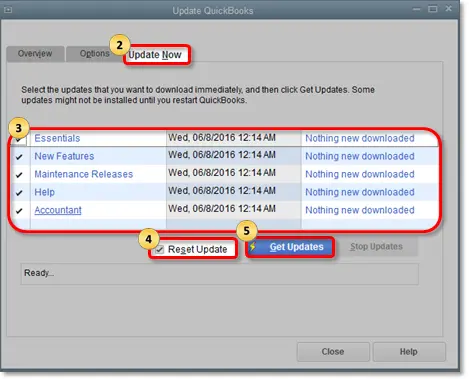
After installing the updates, rerun QuickBooks and try to access your company file. If you still face the error code, move to troubleshooting solution 2.
Solution 2 – Run the QuickBooks File Doctor Utility
As discussed, a damaged or corrupted company file can be a reason for the QuickBooks company file error 6000 1076. To fix this issue, you must use QuickBooks File Doctor and run a repair in the following manner –
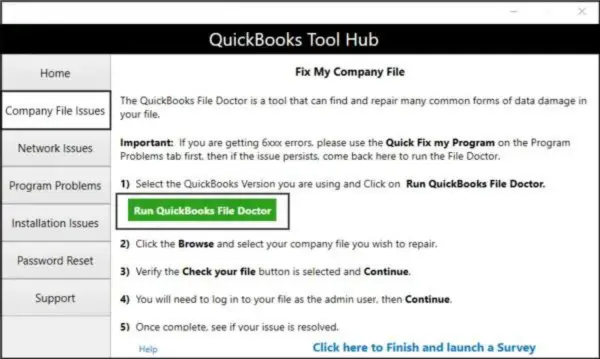
- First, download and install the latest QuickBooks Tool Hub version (1.6.0.5) on your PC.
- Now, launch the QB Tool Hub and run the Quick Fix My File tool under the Company File Issues tab to repair the company file. Once the tool stops, check if you still encounter the error code while accessing the company file.
- If you still get the error, run the QuickBooks File Doctor utility to scan the company files and fix any potential issues.
After running QB File Doctor, rerun QBDT and open the company file to check if the error is fixed.
If you encounter the same error when opening the file on your local PC, go through the next section and implement advanced troubleshooting solutions when accessing the company file stored locally.
Fix QuickBooks Error 6000 1076 While Opening Company File Locally
You can fix the 6000-series errors like 6000 1076 by implementing the advanced troubleshooting solutions below –
Solution 1 – Edit the Network Data and Transaction Log File Names
The Network Data and Transaction Log files are essential configuration files that allow QB to access the company files over the network and locally. If these files get damaged or corrupted, you will face company file access errors, like QuickBooks error 6000 1076. To fix the error, edit the file names to prompt QuickBooks to create fresh ones –
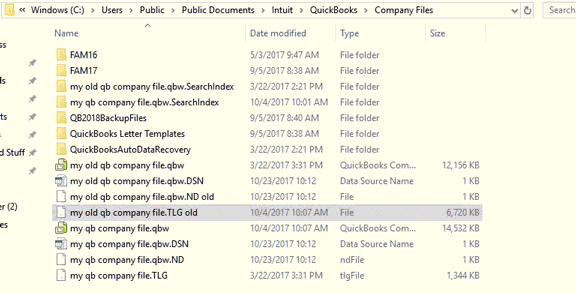
Note: Renaming the files won’t lead to any risk of data loss. QB recreates these configuration files when you scan with QB Database Server Manager or open your company data file.
- Firstly, open the QuickBooks company file folder and search for the files with the .ND and .TLG extensions that have the same name as your company file. If you can’t locate these files, check the settings on your Windows OS to ensure hidden files and folders are displayed.
- Next, right-click each file, select Rename, add .OLD at the end of the file name, and hit Enter to save the changes.
Once done, reopen QuickBooks and sign in to your company file again. If you still encounter the error code, follow solution 2 below to resolve it.
Solution 2 – Open a QB Sample Company File
QuickBooks Desktop error codes -6000 -1076 can arise due to issues within your company file or with the QuickBooks program. To pinpoint where the problem lies, you can try opening a sample company file in the following manner –

- Open QuickBooks, go to the No Company Open window and select the Open a Sample File option.
- Now, choose a file from the list of sample company files and check if it opens.
Once done, undertake the following steps based on the result –
- If the sample file doesn’t open, your QuickBooks installation is damaged or corrupted. To fix the damage, you need to run a QB repair using solution 3 below.
- If the sample file opens, the problem lies with your company file. To fix it, move to troubleshooting solution 4 below.
Solution 3 – Repair QB Desktop
If you find damage to the QuickBooks Desktop a reason for getting the error, run a repair with the QuickBooks Tool Hub tools in the following manner –
- Firstly, open the QuickBooks Tool Hub, then run the Quick Fix My Program tool to repair the program problems in QBDT. After running the tool, try to access the company file and check the status of QuickBooks error 6000 1076.
- If the error persists, run the QuickBooks Install Diagnostic tool to repair the damaged installation and fix the installation problems.
Once the tool stops running, try to access your QB company file again to check if the error is fixed.
Solution 4 – Open the Company File from Another Location
If the sample file opens in Solution 2 above, you need to check if the company file or the file folder is damaged. To identify where the issue lies, copy the company file to another location (your desktop) and access it from there by implementing the following steps –
- Open the QB company file folder and locate the file with .QBW extension, then right-click on it.
- Further, select Copy, right-click on an empty space on your desktop, and click Paste.
- Hold the Ctrl key and open QuickBooks to access the No Company Open window, then select Open or Restore an Existing Company.
- Lastly, go to your desktop, find the company file you recently copied, and open it.
Suppose the company file opens from the new location; your original company file folder might be damaged or corrupted. It is also possible that the file is in multiple folders or exceeds the file system path limitation.
On the other hand, if the file doesn’t open, the QB company file is damaged. In this case, try to restore the company file backup by following the next solution.
Solution 5 – Restore the Company File Backup Copy
You can restore the backup copy of your company file to determine if the problem is with your current company file. QuickBooks uses the backup version to create a new company file when you restore the backup. To restore the backup company file, implement the following steps –
- Firstly, ensure the backup file is on the local hard drive, not an external device. If the backup is stored on an external drive, move it to the local drive, then open QuickBooks.
- Go to the File menu, select Open or Restore Company, then click the Restore a Backup Copy option and click Next.
- Now, browse your PC for the backup file, which should look like – [Your company name].qbb, then select a folder to save the restored version.
Note: To avoid overwriting the data, ensure the backup is not saved in the same folder as the existing company file. Alternatively, you can rename the existing file or the backup to ensure the names don’t match. - Lastly, select Open, and click Save when you are ready. If you get any message related to data overwriting, choose the option you prefer best, and don’t overwrite any data unless you are sure.
Now, your backup company file will be successfully restored. However, if you get an error while restoring the company file backup, follow the steps given below –
Make Sure QuickBooks is Not Hosting the Company File
Check the hosting setup to ensure QB is not hosting the company file over the network in the following manner. You can only restore a backup when QuickBooks is running in single-user mode –
- Open QuickBooks, go to the File menu, select Utilities, and check if the Stop Hosting Multi-User Access option is listed.
- If yes, select the option to disable hosting, then click Yes in Stop Hosting Multi-User Access.
- Further, click Yes in the “Company file must be closed” window and save the settings.
Ensure the Company File Path Limitations are Met
You might face issues accessing the company file or restoring the backup if the company file path is too long and exceeds the limitations. To ensure that the file path is not longer than 210 characters, follow the steps given below –
- Go to the QB company file location, copy the file path from the address bar, and paste it into Notepad.
- Next, count the characters and the spaces to ensure the path isn’t longer than 210 characters. For instance, C:Documents and SettingsAll UsersDocumentsIntuitQuickBooksSample Company FilesQuickBooks 2022Sample_company_file.qbw is 125 characters long.
Once done, rerun the backup restore process, then check the status of QuickBooks error 6000 1076 when opening the company file. If the error code keeps appearing, use the ADR tool in the next solution.
Solution 6 – Use the ADR Tool to Recover Damaged Data
If your company file is damaged and restoring the backup doesn’t help, you can use the QuickBooks Auto Data Recovery. The ADR feature in QuickBooks Desktop helps recover all or almost all of your corrupted or missing data by –
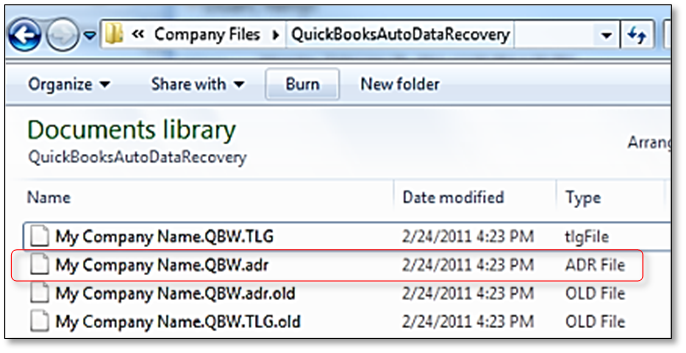
- Restoring the lost/missing/corrupted transactions using the QB Transaction Log file and a copy of the company data file.
- Restoring all the missing/corrupted transactions except the last few hours using a copy of the company data file and the Transaction Log file.
Note: Before using the ADR tool, ensure QBDT is updated and the file size limitations are adhered to. QB won’t generate the ADR file if the backup is more than 1.5 GB. Moreover, the ADR feature is only available in QuickBooks Pro, Premier, and Enterprise versions and not in the Accountant Editions.
Now, let’s use the ADR feature and recover the lost/corrupted transactions by implementing the following steps –
Use the Transaction Log File & the ADR Version of the Company File to Restore Recent Transactions
Recover all the recent transactions by utilizing the QB Transaction Log file and the ADR version of the company data file in the following way –
- First, create a new folder named QBTest on the PC and open the company file folder. If you can’t find the file folder, find the company file location in the Product Information window (press F2 or Ctrl + 1) to open the No Company Open window.
- Find the .TLG file that has the same name as your company file, but if you can’t locate it, edit the Windows settings to display the extensions of the file using the instructions below –
- Open Windows File Explorer by pressing the Windows + E keys, then click Organize.
- Further, select Folder and search options, uncheck Hide extensions for known file types, and select Apply & OK to apply the changes.
- Next, copy the .TLG file that corresponds to your company file and paste it to the QBTest folder created in Step 1 above.
- Open the QuickBooksAutoDataRecovery folder, which is in the same location as your company file, then copy the .QBW.adr file.
- Now, paste the .QBW.adr file into the QBTEST folder so that the folder contains both the .QBW.adr and .TLG files.
- Further, right-click the .QBW.adr file, choose Rename, delete .adr from the end of the file name, and press Enter.
- Run QBDT, open the company file saved in the QBTest folder, and review the transactions.
- Use the account register to ensure all transactions are present, then navigate to the QB File tab.
- Select the Utilities tab and click the Verify Data tool to verify the data integrity of the recovered file.
- If the recovered copy of the company data file confirms integrity, move the damaged company file to another folder/location and transfer the copy from QBTest to the original file location.
You have now successfully restored all the recent missing/corrupted transactions in QuickBooks Desktop. However, if you want to recover all transactions except the last 12 hours, perform the steps in the next section.
Use the ADR versions of the Transaction Log and Company File to Restore All transactions except the Last 12 Hours
You can use the ADR versions of the Transaction Log and company data files to recover all except the last 12 hours of transactions in the following manner –
- Create a new folder named QBTest on your desktop, then open the folder containing your company file. If you can’t find the company file location, find it in the Product Information screen (press F2 or Ctrl + 1) or the No Company Open window.
- Further, find the QuickBooksAutoDataRecovery folder and locate the .TLG.adr and .QBW.adr files having the same name as your company file. If you can’t locate the files, change the Windows settings to display file extensions (go through point 2 in the ‘Use the Transaction Log File & the ADR Version of the Company File to Restore Recent Transactions’ section of this solution).
- Copy the .TLG.adr and .QBW.adr files, paste them into the recently created QBTest folder, then rename them.
- To rename the files, right-click them, select Rename, and remove .adr from the end of the file names so that you have the .QBW and .TLG files in the folder.
- Next, run QuickBooks, open the company file saved in the QBTest folder, and use the account register to verify the transactions.
- Verify that all transactions are there, then go to the File menu and select the Utilities tab.
- Click the Verify Data tool to confirm the recovered file’s data integrity and ensure it is in good condition.
- If the recovered file is in good shape and confirms data integrity, transfer the damaged company file to another location and move the copy from the QBTest folder to the original file location.
Once the ADR process is complete, rerun QuickBooks and sign in to your company file again. Now, check if you can open the company file and if the issue is fixed.
On the other hand, if you encounter the error 6000 1076 while opening the company file on a network, proceed to the next section to learn how to troubleshoot it.
Fix QuickBooks Error 6000 1076 While Opening Company File Over a Network
If you are facing error 6000 1076 while accessing the company file on a network, perform the practical solutions given below to fix it –
Solution 1 – Ensure the Hosting is Disabled on All Workstations
You need to ensure that you use one computer or server PC to host the company files. Thus, make sure the hosting is off on all the workstations by following the steps below –
- Firstly, press the F2 key to get the Product Information window, then find the Local Server Information.
- Now, check the hosting setting and ensure it is turned off on all the workstations.
Once done, try to access the company file, but if you cannot open the company file due to error 6000 1076, move to the next solution.
Solution 2 – Rename the .ND and .TLG Files and Use QB Database Server Manager
Since the .ND and .TLG files are required to access the company files over the network; damage to these files can lead to file access errors. To fix this error while accessing the files in multi-user mode, follow the steps given below –
- Firstly, rename the Network Data and Transaction Log files to fix the file damage. Follow ‘Solution 1: Edit the Network Data and Transaction Log File Names’ of the ‘Fix QuickBooks Error 6000 1076 While Opening Company File Locally’ section above to rename the files. Remember, renaming these configuration files doesn’t cause data loss.
- After renaming the .ND and .TLG files, run a scan using QuickBooks Database Server Manager. QuickBooks recreates the Network Data and Transaction Log files when you scan them with QBDBSM and when opening the company file.
Once the QuickBooks Database Server Manager fixes the network problems, try to open the company file again. However, if you still can’t open your company file error -6000 -1076, move to the next solution.
Solution 3 – Open a Sample QB Company File
You can try opening a sample file to determine if issues in the company file or the QB program cause the error. Follow the ‘Solution 2: Open a QB Sample File’ of the ‘Fix QuickBooks Error 6000 1076 While Opening Company File Locally’ section to access the company file.
Now, take the following actions based on whether you can open the file or not –
- If the file doesn’t open, QB Desktop is damaged, and you must repair it. To run the repair process, follow ‘Solution 3: Repair QB Desktop’ of the ‘Fix QuickBooks Error 6000 1076 While Opening Company File Locally’ section of this blog.
- If the file opens, the original company or folder is damaged. To check whether the damage is with the file or folder, follow ‘Solution 4: Open the Company File from Another Location’ of the ‘Fix QuickBooks Error 6000 1076 While Opening Company File Locally’ section above.
However, if you still encounter the same company file error over the network, move to the next solution.
Solution 4 – Terminate the QB Desktop Processes
You can try terminating all the .EXE processes used by QuickBooks Desktop before reopening the company file. To end these QB processes, implement the following steps –
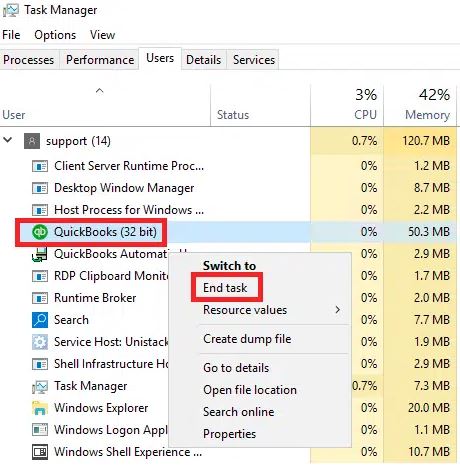
- Go to the server PC, sign in as an Admin user, then press the Ctrl + Shift + Esc keys.
- Now, in the Task Manager, check out the processes for all users, then click Users.
- Lastly, right-click each QB process (QBW32.exe, qbupdate.exe, QBDBMgr.exe) and click the End Task option.
Once the processes are terminated, try opening the QB company file in multi-user mode. If QuickBooks error message 6000 1076 still appears, follow the next solution.
Solution 5 – Review the Folder Sharing Permissions
Inadequate permissions to share the company file folders in multi-user mode can lead to one or more 6000-series errors. To fix this, set up proper Windows permissions for the QB company file folder as follows –
Set Up Folder Permissions for QBDataServiceUser
You must review the Windows permission settings to ensure they are correctly set. To verify the folder permissions for QBDataServiceUser, perform the following steps –
- Go to the Windows Start menu, open Windows File Explorer, navigate to the QB company file folder, and right-click it.
- Further, select Properties, then move to the Security tab and click the Advanced option.
- Next, select QBDataServiceUserXX, click Edit, and set the following settings to Allowed:
- Traverse Folder/Execute File
- List Folder/Read Data
- Read Attributes
- Read Extended Attributes
- Create Files/Write Data
- Create Folders/Append Data
- Write Attributes
- Write Extended Attributes
- Read Permissions
If the permissions are incorrectly set, provide full control to QBDataServiceUser by performing the following steps –
- Right-click the company file folder, choose Properties, then navigate to the Security menu.
- Click Edit, select QBDataServiceUserXX, then choose Full Control and click Allow.
Save the changes, then proceed to the next section to set proper Windows permissions for sharing the company files.
Set Windows Permissions to Share QuickBooks Company Files
You must set proper file-sharing permissions to access your QB company files over the network. Go through the steps mentioned below to set the Windows folder-sharing permissions –
Windows 10
To set permissions to share the QB company files on Windows 10, go through the following steps –
- Firstly, open the Windows Start menu and select Windows File Explorer, then locate the company file folder.
- Right-click the company file folder, select Properties, and click the Sharing option.
- Now, select Share Add and choose the corresponding QBDataServiceUserXX for your QBDT version.
- Lastly, select Full Control as the permission level for users and click Share.
Windows Server 2012
Firstly, ensure that the File and Storage Services are installed, then follow the steps given below to set permissions to share company files in Windows Server 2012 –
- Open the Windows Start menu, type “Run” into the search bar, and select it to open the Run Command window.
- Next, type in “ServerManager,” select OK, and click File and Storage Services.
- Select Shares, then open the Task drop-down menu and choose New Share. A list of File Share Profile will appear, wherein you can learn about the differences between the profiles by reading their descriptions.
- Further, click SMB Share – Quick, which is the default profile, and go to the Share location section.
Note: Remember, the default profile selection may vary. - Select Type a custom path, click Browse to locate the folder you wish to share, and choose the appropriate folder.
- Click Select a folder, hit Next, then go to the Configure Share Settings window.
Note: You can continue with the default selections in the Configure Share Settings window and click Next again.
Once the permissions are correctly set, rerun QuickBooks and open your company file over the network. However, if you still face QuickBooks error code 6000 1076, perform the following troubleshooting solution.
Solution 6 – Configure Windows Firewall and Anti-Virus Settings
Windows firewall or your anti-virus app might be blocking access to specific programs or files, which can lead to this company file error. To fix the error, you must configure the Windows firewall and antivirus settings and remove restrictions while running QB.
After configuring the settings, rerun QuickBooks and open your company file over the network. Check that you can access the file seamlessly and that the error code is eliminated.
Reasons that Lead to QuickBooks Desktop Error 6000 1076
There are several possible reasons behind error 6000 1076 in QuickBooks. Knowing these reasons will help figure out the most effective troubleshooting solution and also help prevent getting into such situations. The following is the list of reasons responsible for QB error 6000 1076 –
- Not having the latest QuickBooks Desktop updates is causing compatibility issues while opening the company file.
- The company data file you are trying to access might be damaged or corrupted.
- Essential QB configuration files, like the Network Data and Transaction Log files, might be damaged/corrupted.
- The company file might be stored on an external or network drive, or the file location might be incorrectly set in QuickBooks.
- The folder containing the QB company file might be damaged or corrupted.
- The company file path might be longer than 210 characters, or the file might be stored in multiple folders.
- There are hosting issues, such as incorrect or misconfigured QB hosting settings.
- There are inadequate Windows file access permissions to share the company files over the network.
- Incorrect or misconfigured Windows firewall and security settings can also lead to the 6000 error code.
- Your QuickBooks Desktop isn’t correctly installed or might be damaged or corrupted.
These are the leading reasons for encountering error 6000 1076 while accessing the company file. In the next section, we will learn how to fix this error by implementing the experts’ suggested solutions.
Conclusion
The troubleshooting solutions in this blog will help you effectively resolve QuickBooks error 6000 1076.
FAQ’s
How can I create a company file backup in QuickBooks Desktop?
It is essential to back up your company file to prevent accidental data loss in case of issues and errors, like QuickBooks error 6000 1076. To create a company file backup, go through the following steps –
-Go to the QuickBooks File menu, select Switch to Single-User Mode, and then return to the File menu.
-Select Backup Company, click Create Local Backup, and select Local Backup in the next window.
-Click Next, then move to the Local Backup Only section, and select Browse to choose where you want to save the backup file.
-Set the number of backups (optional), then let QB run a test to confirm that the backup file is in good condition.
-Lastly, click OK when ready, select Save it Now, and hit Next.
What are the signs and symptoms of QuickBooks error code 6000 1076?
The following common signs and symptoms can help you identify errors like QB error 6000 1076 –
-QuickBooks might not open your company file, or the app might freeze when you sign in to the company file.
-QuickBooks might crash while accessing the company file over the network.
-The application might run slowly and take longer to respond to your commands.
-QB might indicate that the file is only “read-only” while you try to open the company file.
-Other applications might get affected, and you may notice slow performance.
How do I fix QB installation damage causing QuickBooks error 6000 1076?
As the blog mentions, you can repair QuickBooks using the QB Tool Hub utilities. However, if that doesn’t help, you can reinstall QuickBooks Desktop to eliminate the installation problems in the current version.
You May Also Read-
QuickBooks Error 6175 – Quick & Easy Troubleshooting Methods
A step-by-step easy Guide to Fix QuickBooks Error H505
Step-by-Step Guide To Resolve The Error QuickBooks Save As PDF is Not Working
A Quick & Simple Guide To Troubleshoot QuickBooks Error 15243
How to Resolve QuickBooks Error 181021 in Simple and Quick Steps

James Richard is a skilled technical writer with 16 years of experience at QDM. His expertise covers data migration, conversion, and desktop errors for QuickBooks. He excels at explaining complex technical topics clearly and simply for readers. Through engaging, informative blog posts, James makes even the most challenging QuickBooks issues feel manageable. With his passion for writing and deep knowledge, he is a trusted resource for anyone seeking clarity on accounting software problems.
